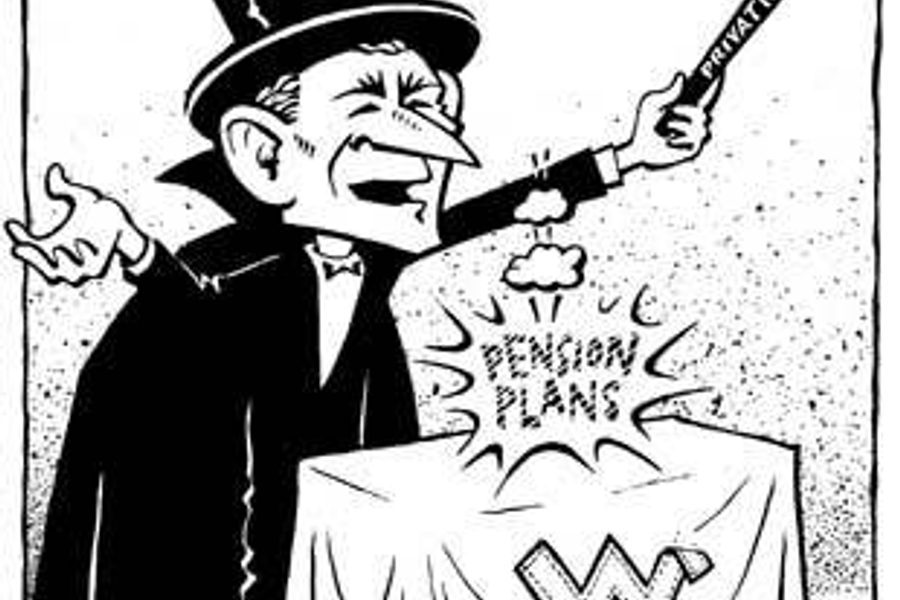Crash Landing
United Airlines’ ditching of this pensions may well precipitate a national crisis
Jack Rasmus

On May 10, a federal court announced United Airlines could pocket $3.2 billion of the contributions owed to its 134,000 workers’ pension plans, and turn over its four pensions to the government’s Pension Benefit Guaranty Corporation (PBGC). The move will leave the PBGC saddled with $9.8 billion in total pension liabilities from United, making it the largest bailout of a private pension fund in more than three decades, at a time when the PBGC faces tens of billions in mounting red ink and possible bankruptcy itself.
The court’s action is also likely to set in motion a snowball effect as other major airlines move to jettison their pension plans. The effects could spill over to other industries – including the auto industry, where there are similar rumblings – as corporate America accelerates its dismantling of union-negotiated Defined Benefit Pension plans, which promise participants a specific monthly benefit at retirement, and seeks to replace them with privatized 401K-like contribution plans.
United’s abandonment comes barely a year after Congress passed legislation in April 2004 that gave the airline a two-year, $1.6 billion reprieve in deferred pension fund payments. United CEO Glenn Tilton happily declared at the time, “This legislation will help strengthen the pension plans of millions of American workers, including the 62,000 employees of United Airlines.”
But now, those employees have been left holding the bag. The takeover of their pensions’ obligations by the PBGC will mean significant reductions in their pension benefit payments at retirement. A January 30 Wall Street Journal article estimated that, “For a 45-year-old whose plan fails this year, for example, the government covers a maximum of $11,403 a year, even if he has earned a larger pension.”
A gathering storm
But United’s nearly $10 billion abandonment is only a drop in the bucket of endangered pension plans. Between 1985 and 2002, U.S. corporations have abandoned more than 80,000 Defined Benefit Pension plans, according to 2003 Senate hearings that examined both the shoddy condition of corporate pension funds and the PBGC’s ability to handle future terminations.
Since 2000, more than 9,000 such plans have been terminated, with more than twice terminated in 2004 than the previous year. During the ‘90s, the PBGC assumed, on average, pension payment liabilities for an additional 50,000 workers each year. That annual liability for pension benefit payments has increased since 2000 to an average of an additional 175,000 workers a year. The recent action by United Airlines promises to set off yet another wave among companies in a similar position, such as Delta, Continental and Greyhound, triggering an even more severe pension crisis.
The growing number of corporations dumping traditional pension plans upon the back of the PBGC has placed severe stress on its ability to guarantee even reduced pension benefits to workers. In 2004, the PBGC experienced the largest financial loss in its history, $23 billion. This followed an $11 billion loss in 2003, with multibillion dollar losses each year since 2000.
Thus, the PBGC now faces its own funding crisis. It has an immediate liability of $62 billion in pension benefit payments and assets of only $39 billion. Should other airlines and other industries follow United’s course, that crisis will grow much worse – likely requiring a major bailout by Congress of the Defined Benefit Pension plans that the PBGC is responsible for.
Referring to this $23 billion deficit, Rep. Jan Schakowsky told reporters on May 10, “Taxpayers had better buckle up because we will be in for a bumpy ride of bailout after bailout, as more and more coporations dump their pension plan obligations on the PBGC.” She and Rep. George Miller (D-Calif.) have co-sponsored the Pension Fairness and Full Disclosure Act, which would deny payments to executives’ plans if worker pension plan obligations were underfunded.
But the current deficit is only part of the problem. In an emergency report issued in June 2004, the PBGC estimated that more than 1,000 pension plans were under-funded by $50 million or more – a combined under-funded liability of $278.6 billion. And that doesn’t include the thousands of other companies with under-funded liabilities of less than $50 million.
The aggregate total under-funding of corporate pension plans for which the PBGC is liable as of 2004 amounts to more than $600 billion. About $100 billion of that under-funding represents corporations and plans with severe financial problems and thus a high likelihood of pension plan default and termination in the near term.
In the words of the PBGC’s executive director, Bradley Belt, “The current massive under-funding of defined benefit pensions, compounded by the financial struggles of major industries that rely heavily on these pensions, has greatly increased the risk of loss for the pension insurance program.”
Bush’s red herring
While President Bush stresses a financial crisis in Social Security in order to push his plans to privatize that public retirement system, a very real crisis in the traditional Defined Benefit Pension plan system is coming closer by the day.
The April 2004 legislation passed by Congress amounted to a two-year, $80 billion “pension contributions holiday” for corporations with under-funded pension liabilities, but it was basically a stopgap measure. In January, Bush proposed legislation to the House and Senate that would allow companies with severely under-funded pension plans to take up to 10 years to make up contributions to stabilize their funds, instead of the two years that had previously been required. A single corporate bond interest rate to calculate the value of a pension’s fund was proposed, but it is a highly complicated formula that would provide many opportunities for corporations to manipulate and thus avoid accurately estimating their fund’s true value. Finally, a sharp increase in corporate contributions to the PBGC, from the previous $19 per worker to $30 per worker, was proposed. For corporations with “below investment grade” pension funds the PBGC contribution would be even higher than $30.
This last proposal seems designed to encourage corporations in trouble to abandon their Defined Benefit Pension plans even faster than before. Should Congress pass Bush’s proposals this year, companies with ratings below investment grade, like U.S. Steel, Lucent, Goodyear, Qwest and R.J. Reynolds – not to mention most of the remaining major airlines – will now seriously consider dumping their pensions onto the already financially stressed PBGC.
Perhaps that is just what the Bush administration wants. It would certainly hasten the demise of the traditional Defined Benefit Pension system and usher the way for Bush’s preferred “ownership society,” replacing group pensions with 401k-like individual pension accounts.
Congress began considering legislation based on the Bush proposal in March. In the upcoming months, decisions will be made on further restructuring of the private pension system, the import of which is no less consequential than the parallel debate regarding the restructuring of Social Security.
Today, 44 million people receive Social Security Retirement benefits. But there are 45 million workers who are dependent on Defined Benefit Pensions with a potential total liability of $1.5 trillion. While the fight continues over Social Security privatization and restructuring in a highly visible public manner, the equally significant conflict over what will happen to these pensions has occurred far below the public’s radar.








